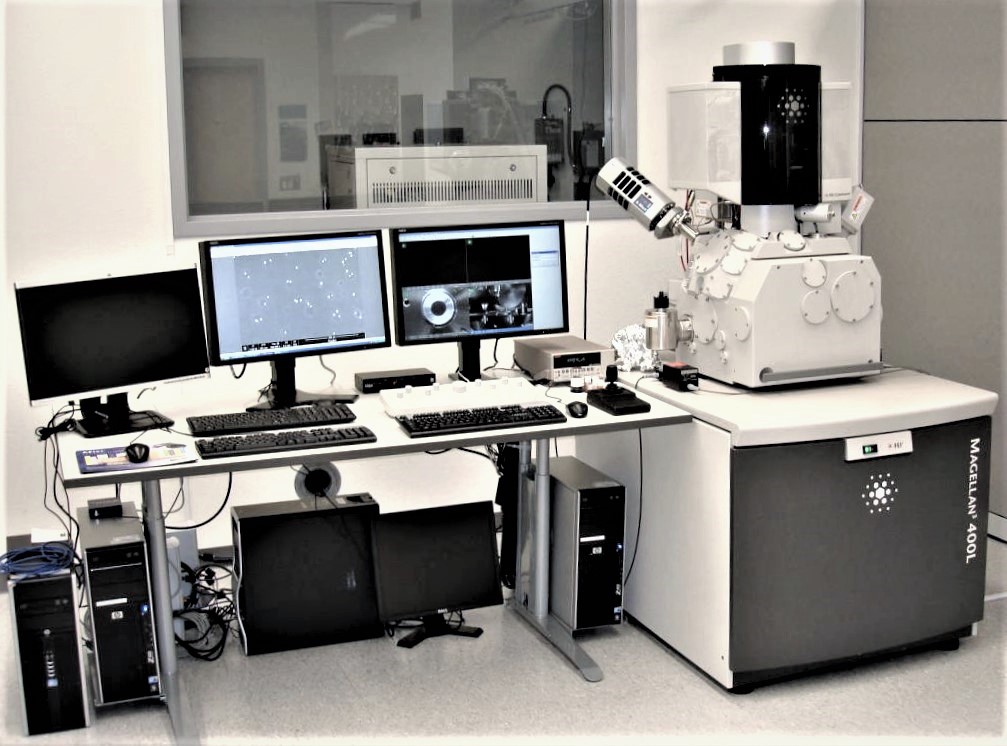FEI Magellan 400 XHR SEM
| Location | 1302 Calit2 Building |
| Contact: | Dr. Qiyin Lin |
| Email: | qiyinl@uci.edu |
| EMERGENCY: | 9-1-1 |
| UCI Police: | (949) 824-5223 |
| UCI Medical Center: | (714) 456-6123 |
| Usage ($) | Training ($) | |
| UC Campuses |
451/302 | 40.00 |
| Other Academic |
58.51/392 | 52.00 |
| Industrial |
1351/902 | 120.00 |
NOTE: 1On-Peak rate. 2Off-Peak rate. Typical training time: 5 Hours. Training is billed per hour per person. Usage is billed per hour.
| Keycard Access: | Daytime or 24/7 |
| Instrument Access: | Daytime or 24/7 |
NOTE: Keycard access is required at all times to enter the TEM Labs. Users who have yet trained are not permitted to operate any lab instruments. Users who wish to bring guests are required to notify the Lab Manager in advance.

Description
FEI Magellan XHR SEM system extreme high resolution (XHR) SEM. Its innovative electron-optical elements, beam deceleration, and immersion capabilities allow the Magellan to support flexible imaging operations and refined topographic and materials information. Magellan enables users to explore further into smaller and finer details with its flexibility and ability to observe nanoscale surface details, particles, and material interfaces and analyze chemical information.
The combination of high collection efficiency through-lens detector (TLD), the unique low voltage (UC mode), beam deceleration and immersion capabilities allows the Magellan to support complex imaging operations and refined topographic and materials information. The 5 axis piezoceramic Magellan stage allows for a wide travel range in a highly adaptative and large chamber. Both small and large samples can be positioned under the beam in virtually any orientation.
Sample transfer can be completed in minutes, using the quickloader.
Sample sizes and holders:
• Maximum size: 100 mm diameter with full rotation
• Maximum thickness: 8.7 mm (via quickloader with the standard shuttle including stub)
20 mm (via chamber door):
• Weight: 200 g (including holder)
• Rotation: 360 ° continuous
Holders: Multi-stub holder (std for 400 L)
Cross-sectional holder (std for 400 L)
Single stub mount, mounts directly onto stage
Instrument Features
- Everhart-Thornley Detector
- Through-The-Lens Detector (TLD) for HRSEM
- UC Mode for Low Voltage SEM
- Immersion Mode for HRSEM
- Concentric Backscatter Electron (CBS) Detector
- Scanning Transmission Electron Microscopy (STEM) Detector
- EDS: Oxford Silicon Drift Detector (80 mm2) and Both INCA and AZtec Software
- Nabity NPGS (Nanometer Pattern Generation System) for EBL
- Kleindiek Probe System
- Stage Bias
Popular Applications
- High-Resolution SEM (HRSEM)
- Energy Dispersive X-ray spectrometer (EDS)
- Electron Beam Lithography (EBL)
- Back-Scattered Electron (BSE)
- Scanning Transmission Electron Microscopy (STEM) (ADF or BF mode)
- Nanomanipulation and Electrical Measurement with Kleindiek Probe System
Instrument Specifications
| Electron Source & Operating | |
| Beam Voltage | Field Emission Gun 0.1 kV ~ 30 kV |
| Beam Current | 1.6 pA to 64 nA Electron source Schottky thermal field emitter with a UC mode (< 0.2 eV energy spread) |
| Resolution: @ optimum WD | 0.8 nm at 15 kV 0.8 nm at 2 kV 0.9 nm at 1 kV 1.5 nm at 200 V |
| Resolution @ coincident point | 0.8 nm at 15 kV 0.9 nm at 5 kV 1.2 nm at 1 kV |
| Stage: | 5 axes high precision and stability piezoceramic stage XY range: 100 mm, 0.5 µm repeatability Zmax=20mm Tilt: -10° to + 55° |
| –Maximum horizontal field width | 1.5 mm at WD 4 mm |
| Vacuum system | -1 x 210 l/s TMP 1 x PVP (dry pump) 2 x IGP |
| Chamber vacuum | ~3 * 10-6 mbar (after 24 h pumping) |
| — | – |
Useful Information
Instruction & Brochure
Application Notes
SOP & Safety Documents
Standard Operating Procedures